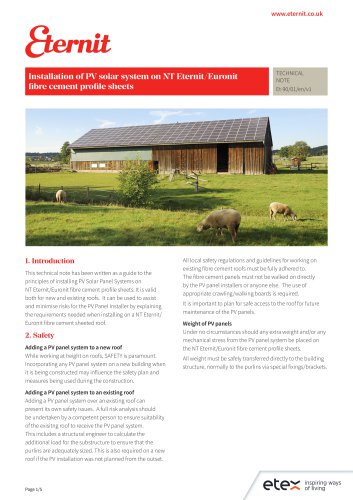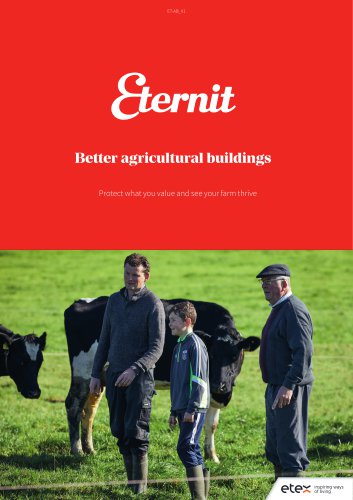
Catalog excerpts
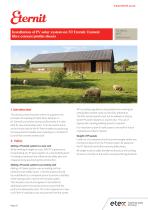
Installation of PV solar system on NT Eternit/Euronit fibre cement profile sheets 1. Introduction This technical note has been written as a guide to the principles of installing PV Solar Panel Systems on NT Eternit/Euronit fibre cement profile sheets. It is valid both for new and existing roofs. It can be used to assist and minimise risks for the PV Panel Installer by explaining the requirements needed when installing on a NT Eternit/ Euronit fibre cement sheeted roof. 2. Safety Adding a PV panel system to a new roof While working at height on roofs, SAFETY is paramount. Incorporating any PV panel system on a new building when it is being constructed may influence the safety plan and measures being used during the construction. Adding a PV panel system to an existing roof Adding a PV panel system over an existing roof can present its own safety issues. A full risk analysis should be undertaken by a competent person to ensure suitability of the exisitng roof to receive the PV panel system. This includes a structural engineer to calculate the additional load for the substructure to ensure that the purlins are adequately sized. This is also required on a new roof if the PV installation was not planned from the outset. All local safety regulations and guidelines for working on existing fibre cement roofs must be fully adhered to. The fibre cement panels must not be walked on directly by the PV panel installers or anyone else. The use of appropriate crawling/walking boards is required. It is important to plan for safe access to the roof for future maintenance of the PV panels. Weight of PV panels Under no circumstances should any extra weight and/or any mechanical stress from the PV panel system be placed on the NT Eternit/Euronit fibre cement profile sheets. All weight must be safely transferred directly to the building structure, normally to the purlins via special fixings/brackets.
Open the catalog to page 1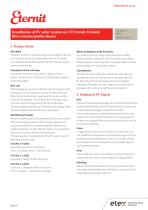
Installation of PV solar system on NT Eternit/Euronit fibre cement profile sheets 3. Design Advice Roof pitch The pitch is a factor in determining a roof’s suitablity. Should the roof pitch not be at its ideal angle then the PV panels may need additional framing that tilts the PV panels to give optimal performance. Before installation of the PV panels Any build-up of moss, fungi or lichen should be safely removed before installation of the PV panels commences. Where necessary repair any leaks, damaged sheets or loose flashings before PV panels are installed. Orientation of the roof slope...
Open the catalog to page 2
Installation of PV solar system on NT Eternit/Euronit fibre cement profile sheets 5. Fixing the PV Panel Frame PV Panel supplier It is the responibility of the PV Panel supplier to provide suitable fixings that do not impact negatively on the NT Eternit/Euronit fibre cement profile sheets. Location of PV panel frame fixings Always position the PV panel frame fixing at the apex or the top of the wave of the NT Eternit/Euronit fibre cement profile sheets. Never place a PV panel frame fixing in the valley or in the sides of the wave of the NT Eternit/Euronit fibre cement profile sheets....
Open the catalog to page 3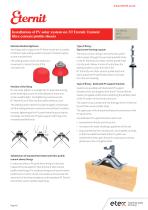
Installation of PV solar system on NT Eternit/Euronit fibre cement profile sheets Maintain Weathertightness Any fixing used to support the PV frame must have a suitable mushroom type sealing washer to prevent moisture ingress via the oversized hole. This sealing washer must not restrict any movement or reduce the size of the oversized hole. Position of the fixing Do not under tighten or overtight the PV panel frame fixing as the building structure must be allowed to move and remain weathertight. Overtightening could cause the NT Eternit/Euronit fibre cement profile sheets to crack. The...
Open the catalog to page 4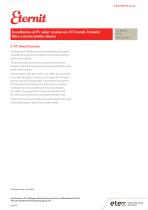
Installation of PV solar system on NT Eternit/Euronit fibre cement profile sheets 6. PV Panel Electrics All design and installation of the complete electrical system including all wiring, and connections is the responsibility of the PV panel Installer. The positioning of any electrical components must not present a risk to the animals or have an adverse effect on the health of the animals. Where possible, plan the route for any cables to ensure they run at the wall gables or eaves, so the cables do not have to pass through the roofing sheets. If penetration through the NT Eternit/Euronit...
Open the catalog to page 5All Eternit catalogs and technical brochures
-
UrbanPro
11 Pages
-
Better agricultural buildings
11 Pages
-
Ventilation Guide
9 Pages

